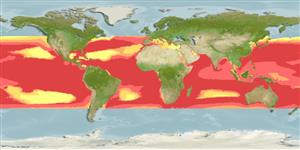Environment: milieu / climate zone / depth range / distribution range
Ecologie
marien; brak water; oceanodroom (Ref. 51243); diepte 0 - 85 m (Ref. 13608), usually 5 - 10 m (Ref. 40849). Subtropical; 21°C - 30°C (Ref. 26); 50°N - 40°S, 180°W - 180°E (Ref. 54341)
Atlantic, Indian and Pacific: in tropical and subtropical waters. Highly migratory species
Lengte bij maturiteit / Grootte / Gewicht / Leeftijd
Maturity: Lm 55.8, range 35 - 93.1 cm
Max length : 210 cm TL mannelijk / geslacht onbekend; (Ref. 9846); common length : 100.0 cm TL mannelijk / geslacht onbekend; (Ref. 3390); max. gepubliceerd gewicht: 40.0 kg (Ref. 30874); max. gerapporteerde leeftijd: 4 Jaren (Ref. 2885)
Dorsale stekels (totaal) : 0; Dorsale zachte stralen (totaal) : 58 - 66; Anale stekels: 0; Anale zachte stralen: 25 - 31; Wervels: 31. This species is distinguished by having the following characters: mature males with prominent bony crest in front of the head; greatest body depth in adults less than 25% of standard length; tooth patch on tongue small and oval; single dorsal fin extending from above eye almost to caudal fin with 58-66 rays; a concave anal fin extending from anus almost to caudal fin; pectoral fin more than half of head length; lateral-line scales at least 200 (Ref. 9648). Colour of body metallic blue-green on the back (fading to grey with green tinge when dead), sides silver with golden sheen, and 1 row of dark spots or golden blotches running below dorsal fin and 1, 2, or more rows on and below lateral line, some scattered irregularly; dorsal and anal fins
black, the latter with a white edge; pectoral fins pale; caudal fin silvery with a golden sheen; in juveniles, only tips of caudal-fin lobes white, pelvic fins black (Ref. 9648).
Adults are found in open waters but also near the coast (Ref. 9293, 11230). Form schools. Feed on almost all forms of fish and zooplankton; also takes crustaceans and squid (Ref. 2850). Sexual maturity is reached in 4-5 months (3 for captive fish) (Ref. 11441). Spawn in the open sea and probably approximate to the coast when water temperature rises (Ref. 9293). Eggs and larvae are pelagic (Ref. 6755). Attracting devices such as floating bundles of bamboo reeds or cork planks are used to concentrate dolphin fish before the nets are set. Marketed frozen (Ref. 9987) and fresh and is of high value (Ref. 9293). Caught by trolling and on tuna longlines; also occasionally with drift nets (Ref. 9846).
In East African waters, spawning season may last from March to early June and spawning occurs inshore. In the western Pacific, sex ratios were about equal during spawning season. Spawning in the western Atlantic occurs over an extended period of time.
Spawn naturally in captivity without artificial inducement (Ref. 41779).
Palko, B.J., G.L. Beardsley and W.J. Richards, 1982. Synopsis of the biological data on dolphin-fishes, Coryphaena hippurus Linnaeus and Coryphaena equiselis Linnaeus. FAO Fish. Synop. (130); NOAA Tech. Rep. NMFS Circ. (443). (Ref. 26)
Status op de Rode Lijst van het IUCN (Ref. 130435: Version 2024-1)
Gevaar voor de mens
Reports of ciguatera poisoning (Ref. 30911)
Gebruik door de mens
Visserij: van groot commercieel belang; Aquacultuur: commercieel; sportvis: ja
Tools
Speciale rapporten
Download XML
Internetbronnen
Estimates based on models
Preferred temperature (Ref.
123201): 18.1 - 29.1, mean 27.4 °C (based on 5894 cells).
Fylogenetische diversiteitsindex (Ref.
82804): PD
50 = 1.0000 [Uniqueness, from 0.5 = low to 2.0 = high].
Bayesian length-weight: a=0.01349 (0.01055 - 0.01724), b=2.88 (2.81 - 2.95), in cm total length, based on LWR estimates for this species (Ref.
93245).
Trofisch niveau (Ref.
69278): 4.4 ±0.0 se; based on diet studies.
Generation time: 1.1 (0.7 - 2.7) years. Estimated as median ln(3)/K based on 15
growth studies.
Weerstandsvermogen (Ref.
120179): Hoog, minimale populatieverdubbelingstijd minder dan 15 maanden (K=0.4-1.2; tm<1; tmax=5; Fec=85,000).
Prior r = 1.09, 95% CL = 0.72 - 1.64, Based on 7 data-limited stock assessments.
Fishing Vulnerability (Ref.
59153): Moderate vulnerability (41 of 100).
Climate Vulnerability (Ref.
125649): High to very high vulnerability (70 of 100).
Nutrients (Ref.
124155): Calcium = 61.9 [27.9, 135.3] mg/100g; Iron = 1.59 [0.82, 3.12] mg/100g; Protein = 20.1 [18.8, 21.4] %; Omega3 = 0.237 [0.109, 0.518] g/100g; Selenium = 51.9 [21.7, 122.7] μg/100g; VitaminA = 2.57 [0.64, 11.45] μg/100g; Zinc = 0.54 [0.34, 0.88] mg/100g (wet weight); based on
nutrient studies.
